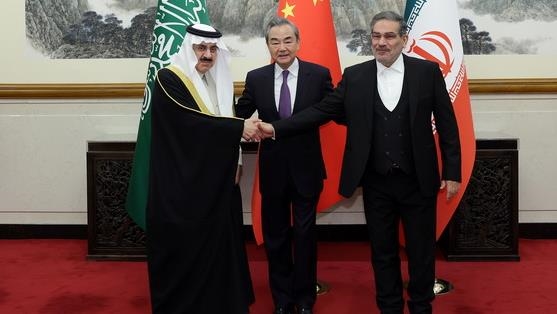TEHRAN, Iran
Regional arch-foes and estranged neighbors, Iran and Saudi Arabia, finally broke the diplomatic ice after almost two years of marathon efforts to resume ties and reopen embassies.
The surprise announcement came on Friday after several days of intense deliberations between the top security officials of the two countries in Beijing, facilitated by the Chinese government.
While Iraq brokered the tension-easing talks between Tehran and Riyadh for the most part since April 2021, the breakthrough came in Beijing at the initiative of President Xi Jinping.
A well-informed senior diplomat in Tehran told Anadolu that President Ebrahim Raisi’s visit to Beijing in February, the first by an Iranian president in two decades, paved the way for the breakthrough.
“The ground was already laid, agreements had been reached, both sides demonstrated the necessary political will to mend fences, but the final breakthrough was eluding,” he said.
The offer of mediation, he stressed, came from Beijing which Tehran “readily accepted.”
Iran’s top security official, Ali Shamkhani, also told reporters after signing the joint statement with his Saudi counterpart Musaid Al-Aiban and top Chinese diplomat Wang Yi in Beijing that Raisi’s visit and his meeting with his Chinese counterpart “provided the basis” for the agreement.
He also acknowledged the “valuable role” played by Baghdad in “paving the way for the agreement” in a phone call with Iraqi Prime Minister Mohammad Shia al-Sudani before the joint statement.
Iran and Saudi Arabia fell out after Saudi diplomatic missions in Tehran and Mashhad were attacked by angry mobs in January 2016 following the execution of Saudi Shia cleric Sheikh Nimr al-Nimr.
Since April 2021, they were involved in marathon talks in Baghdad aimed at the restoration of diplomatic ties, but issues such as the protracted Yemen war prevented the breakthrough.
Role of Iraq, Oman
The dialogue aimed at rapprochement between the two Persian Gulf arch-foes started on April 9, 2021, with the war in Yemen where they support opposite sides being the main focus initially.
However, it was not until May 2021 that both sides confirmed they were holding direct talks. In a statement on May 10, 2021, Tehran said it “welcomed the resolution of issues” with Riyadh.
The fence-mending talks, however, were peppered with dramatic pauses. In March 2022, just before the fifth round of talks, Iran pulled out without offering a reason. It came a day after mass executions in Saudi Arabia that reportedly included dozens of Shias.
A month later, the fifth and last round of talks was held in Baghdad, after which the political crisis in the host country led to a stalemate and subsequent protests in Iran complicated the efforts further.
While Baghdad hosted at least five rounds of tension-easing talks between the two sides in two years, Oman is also believed to have played the role of a facilitator without publicly announcing it.
Iranian Foreign Minister Hossein Amir-Abdollahian telephoned his counterparts in both Iraq and Oman on Friday to thank them, his office said. He also spoke to his Qatari counterpart, which is involved in efforts to revive talks aimed at the revival of the 2015 nuclear deal.
“Baghdad and Muscat played instrumental roles in narrowing gaps between the two neighbors to the point that they agreed to escalate talks from security to the political level,” said Humayoun Afshari, a Tehran-based strategic affairs commentator.
“But it was China that helped them cross the finish line,” he added.
Afshari attributed the breakthrough to growing Iran-China political and trade relations amid tensions with the US, and Beijing’s “tremendous influence” in both Tehran and Riyadh.
“It was demonstrated by the way President Xi diffused the crisis that emanated from the joint GCC-China statement in December last year, which breached Iran’s red lines,” he told Anadolu.

